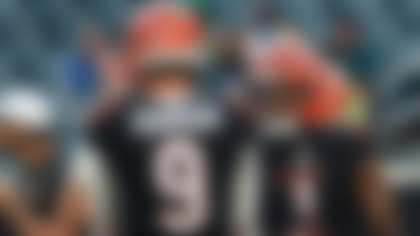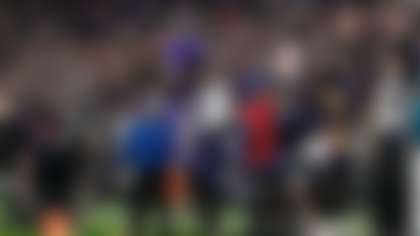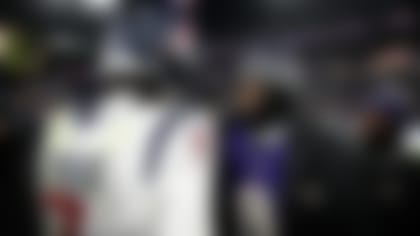It's draft week! And as we get closer to the opening round of action on Thursday night, trade winds are blowing through the rumor mill. Consequently, I've put together four potential deals involving first-round picks.
The work below blends my draft-prospect and team-needs models to provide competitive analysis for each pick. This piece builds off how I approached my mock draft in that its goal is to optimize for wins in the coming season. So, yeah, I aim to net both teams a higher projected win total in 2021, while taking into account which positions/prospects other franchises are likely to draft.
Long story short: These trades would be win-win.
Without further ado, let's get to it!
1) Broncos trade up for a quarterback
Denver receives:
-- 2021 first-round pick (No. 4 overall)
Atlanta receives:
-- 2021 first-round pick (No. 9)
-- 2021 second-round pick (No. 40)
Why it works for the Broncos:
The opportunity to select QB4 in this draft for the cost of a second-round pick -- and not necessarily be forced to immediately start the rookie QB -- is a luxury. The Broncos are closer than it might seem to being postseason contenders. According to my models, Trey Lance and Mac Jones are the two top-tier quarterbacks with the highest probability of being available at No. 4. If I play with the models a little to analyze the scenario of each QB starting 13 games -- and Drew Lock starting four, as opposed to all 17 -- the win share increase is about 0.8 games (Lance is 0.82, Jones is 0.79). I know you can't win fractional games -- remember, these are averages -- but one more full win could mean the difference between getting a postseason bid and spending January on the couch.
Why it works for the Falcons:
The Falcons hold one of the biggest keys to unlocking this whole draft because they have lot of options. They could stay put at No. 4 and select my model's most likely All-Pro (TE Kyle Pitts). They could stick-and-pick a QB for the future to develop behind Matt Ryan. This are two strong options, which allows Atlanta to have discerning tastes when it comes to a third alternative: trading down. New GM Terry Fontenot comes from a Saints organization with an excellent draft track record over the past decade, which helps bolster my argument for Atlanta to trade down to No. 9 and pick up another early second-round selection (they already have No. 35). With such a move, the odds of increasing the Falcons' defensive production potential shifts dramatically. For example, my availability probability model shows that selection No. 9 has a 93 percent chance of offering my model's top corner: Patrick Surtain II, who's being widely mocked to Dallas at No. 10. Selection Nos. 35 and 40 both figure to provide enticing pass-rushing options, and my model would suggest Atlanta doubling down in this area if the team were to execute this deal. The Falcons' win share forecast in 2021 increases 0.7 wins with this trade.
2) If QB stalls after No. 3, Bears pounce
Chicago receives:
-- 2021 first-round pick (No. 11 overall)
New York receives:
-- 2021 first-round pick (No. 20)
-- 2021 second-round pick (No. 52)
-- 2021 sixth-round pick (No. 204)
Why it works for the Bears:
As I said in the blurbage just above, according to my model, QB4 is most likely to be Mac Jones or Trey Lance. Sitting either one of them behind Andy Dalton obviously wouldn't produce a big win-total uptick in 2021. Jones in particular seems like a first-round pick you'd want to test out sooner than later, based on his quick-passing résumé at Alabama. But getting ahead of Washington (picking at No. 19) and New England (No. 15) -- not to mention, Vegas (No. 17) and Philly (No. 12) -- creates future value for the reasonable cost of a second- and sixth-round pick.
Why it works for the Giants:
I may have pointed out before that the Giants paid their free agents well (maybe too well) this offseason. But now that's a sunk cost, and the player-performance projections combine to give this roster some sneaky-good potential. The highest probability fit-based additions (edge, corner, O-line, wide receiver) don't decrease much from 11 to 20, and adding No. 52 outweighs that by about 0.35 wins.
3) Packers finally target a target for Aaron Rodgers
Green Bay receives:
-- 2021 first-round pick (No. 24 overall)
-- 2021 fourth-round pick (No. 140)
Pittsburgh receives:
-- 2021 first-round pick (No. 29)
-- 2021 third-round pick (No. 92)
Why it works for the Packers:
My crystal ball tells me that Aaron Rodgers would do well with just about any of the potentially available WRs in this draft. My math tells me that picking at No. 24 would be more likely to net the Pack WR4 or 5, as opposed picking at No. 29, where WR7 or even WR8 is possible. In this scenario, the Packers leapfrog New Orleans (No. 28 pick), Baltimore (No. 27) and Jacksonville (No. 25) -- three teams that could be eyeing a wideout in Round 1 -- to get their preferred pass catcher for the price of a middle-rounds pick swap.
Why it works for the Steelers:
The Steelers' needs (O-line, edge, running back, corner) create a scenario where the projected WR run could allow them to trade down, get extra draft capital and still end up with the player they wanted in the first place. I plugged in all the fit-specific players at No. 24 and then at 29, and the names did not change much. (Running back was just a 2.8 percent different.) Furthermore, Pittsburgh could flip its acquired No. 92 pick in a second-round trade-up -- maybe moving from No. 55 all the way up to 41 (the Lions own the pick) or 42 (Giants).
4) Raiders move up for a developmental QB
Las Vegas receives:
-- 2021 first-round pick (No. 31 overall)
Baltimore receives:
-- 2021 second-round pick (No. 48)
-- 2021 third-round pick (No. 80)
Why it works for the Raiders:
It seems we've reached the annual point in draft season where everyone starts talking about Jon Gruden's plan at quarterback. Derek Carr is under contract for two more years, but that wouldn't necessary preclude the Raiders from grooming a successor/replacement -- especially considering the potential dead money left on Carr's deal is minimal this offseason and inexistent next offseason. Since the Raiders currently own back-to-back third-round picks (Nos. 79 and 80), they could include the latter selection in a trade for long-term QB stability. Remember, teams get a fifth-year option on first-round picks, which is big when it comes to quarterback selections -- especially developmental quarterback selections. Also, the best trades involve excellent BATNA (Best Alternative To a Negotiated Agreement) -- and in this case, that could equal a top-tier tackle who somehow fell to No. 31. Positional pay is crucial, and QB and OT are highly expensive in free agency.
Why it works for the Ravens:
While the Ravens would lose one first-round pick, they'd still have No. 27 at their disposal. And they'd possess an abundance of Day 2 selections: Nos. 48, 58, 80, 94 and 104. I looked at my "availability probability" model to study which fit-specific players would be available to Baltimore in the first three rounds of the draft. Here, the combination of right tackles, wide receivers and edge rushers increases by 0.5 wins with this hypothetical trade. Think of pick 31 as "worth" 0.3 wins, based on historical contributions in Year 1. Thus, the Ravens would be "giving up" 0.3 wins in order to "earn" 0.5 -- that is a 66 percent increase.
Follow Cynthia Frelund on Twitter.
Want to create your own mock for the 2021 NFL Draft? Check out PFF's draft simulator to play out countless scenarios for every team spanning all seven rounds.




















